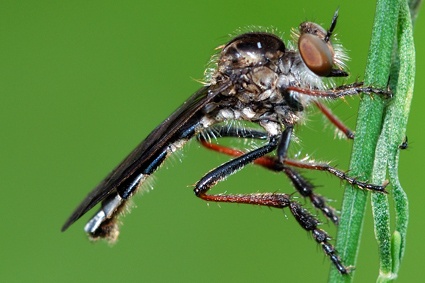Brachyrhopalinae sensu Dikow 2009a

Nicocles politus , image © Michael Thomas.
Brachyrhopalinae
– stylus composed of two elements (58)
– proximal prothoracic tarsomere longer than following two tarsomeres combined (120)
– alula reduced in size to small lobe (130)
– R4 and R5 more or less parallel (133)
The species here summarised within Brachyrhopalinae are the remnant of the Dasypogoninae and Stenopogoninae sensu previous authors. It is a large clade that is not delimited by many unique apomorphic character states. Future phylogenetic studies will hopefully improve the delimitation of this taxon by including additional species that are morphologically similar to the Brachyrhopalinae representatives used here. From the valid and available family-group names represented in this clade, the name Brachyrhopalinae Hardy 1926, with the type genus Brachyrhopala from Australia, is the oldest name and is chosen here to name this taxon.
Brachyrhopalini: Austrosaropogon, Brachyrhopala, Cabasa
– lower facial margin slightly developed (4)
– discal scutellar setae absent (99)
The Brachyrhopalini was described by Hardy (1926) for the only genus Brachyrhopala although he considered Cabasa to be a junior synonym of Brachyrhopala. It is expanded here to include Austrosaropogon.
Ceraturgini: Ceraturgus, Nannocyrtopogon
– facial swelling extending over lower facial three quarters (7)
– hypopharynx parallel-sided throughout and distal tip suddenly pointed (32)
– regular setae form katatergal setae (83)
– male hypopygium rotated (195)
– male cerci fused to single sclerite (212)
– male sperm sac appearing more or less heavily sclerotized (218)
The Ceraturgini was described by Artigas & Papavero (1991) for the two genera Ceraturgus and Myelaphus. Myelaphus is transferred here to the Dioctriinae and Nannocyrtopogon, which is placed in Cyrtopogonini by Artigas & Papavero (1991), is placed in Ceraturgini here.
Chrysopogonini: Chrysopogon, Codula
– single, short, stout macroseta forms notopleural seta (88)
– cuticular facets on proximal metathoracic femora (117)
– prementum of labium laterally compressed (18)
– labellae of labium reduced and fused entirely to prementum (23)
– supra-alar, postalar, and presutural dorsocentral setae absent (90, 91, 92)
– alula well developed (130)
– abdominal tergites indented and setae with large sockets (151)
– female S8 proximally platelike and hypogynial valves forming a keel distally (170)
– female with T9–10 separated (not fused) (173)
– female without spurs on the ovipositor (174)
– female spermathecal reservoir formed by more or less expanded and coiled ducts (180)
– female furcal apodeme present and long (185)
This exclusively Australian taxon was described by Hardy (1934) and was extensively reviewed by Clements (1985). Originally it included only the genera Chrysopogon, Codula, and Opseostlengis, but Hull (1962) later transferred Chryseutria to this taxon. The genus Codula was placed in the Stenopogoninae sensu previous authors in contrast to Chrysopogon, which was placed in Dasypogoninae sensu previous authors, in the most recent generic catalogue (Geller-Grimm, 2004) based on the absence of a prothoracic tibial spine. The close relationship between these two genera is supported here by autapomorphies and the placement of Codula within Chrysopogonini is without doubt.
Cyrtopogonini: Afroholopogon, Cyrtopogon, Dasycyrton
– female T8 with anterior rectangular apodeme, which is entirely fused to the tergite (169)
– female spermathecal reservoir formed by more or less expanded and coiled ducts (180)
The Cyrtopogonini was described by Artigas & Papavero (1991) within their Stenopogoninae for 20 genera. Of these, only Cyrtopogon and Dasycyrton are recovered within this clade and Afroholopogon is referred to this taxon. Other genera originally included by Artigas & Papavero and also part of the present analysis are now found within the unpalced genera of Brachyrhopalinae, i.e., Heteropogon, Holopogon, Metapogon, Nannocyrtopogon, and Rhabdogaster, or transferred to other higher-level taxa, i.e., Ablautus to Willistonininae.
Genera not placed within above tribal taxa:
Heteropogon, Holopogon, Metapogon, and Rhabdogaster were placed in Cyrtopogonini by previous authors, but do not group with Cyrtopogon in Dikow (2009).
Cophura, Leptarthrus, and Nicocles were placed in the unavailable “Isopogonini” (Sabrosky 1999, Dikow 2004) within Dasypogoninae by Papavero (1973) based on the possession of an S-shaped spur on the prothoracic tibiae. These genera do not form a monophyletic clade in the present analysis and therefore a taxon cannot be recognised and no new family-group name was provided by Dikow (2009) to replace the unavailable name.
Although the genera Holopogon and Leptarthrus as well as Cophura, Heteropogon, Metapogon, Nicocles, and Rhabdogaster form clades, respectively, Dikow (2009) did not propose any new family-group names for these taxa as a more detailed study focusing on morphologically similar species will shed light on the phylogenetic relationships within Brachyrhopalinae.
